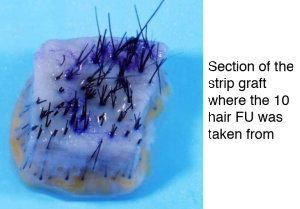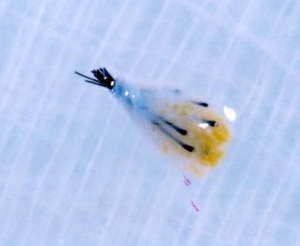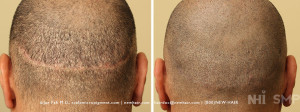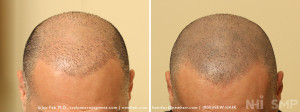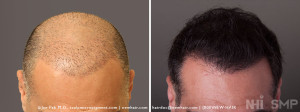The world record follicular unit was found by Dr, Michael Beehner, an excellent hair transplant surgeon in upstate New York. The concept that the New Hair Institute developed and published, points to the great value of transplanting just the follicular units (an FU is the anatomical unit group that grows hair – ). Having identified an FU which normally has been 1-4 hairs each, with 10 hairs, Dr. Beehner will have to decide it he will keep the intact unit for transplantation, or spit this unit into 2-3 separate units. We doctors get excited when we see such unusual findings. I would bet that this patient is a Caucasian with a very high hair density.

I have already gone for tricho analysis they told that I have a very low hair density I.e 100 per square cm. So now I would like to go for hair transplantation is it possible now
Low hair density means you will have less hair available for a hair transplant and your expectation and results will have to be discussed with your doctor. In general a normal hair density for a Caucasian male is 200 hairs in a square centimeter. It is also important to establish a diagnosis of your hair loss type and why you may have a low hair density. If you have a Class 3 pattern (just frontal corner loss), you should be able to have a hair transplant with your low donor hair. But if you have a condition such as diffuse unpatterned alopecia (DUPA) you will not be a candidate for surgery as the condition of the hair in the donor area is not healty. It is not normal to have 100 hairs per square centimeter. I never trust a single measurement, so you might have someone else reaffirm the density numbers.
In a very recent question, asked about hair cloning, you mentioned that “theoretically you will have an endless supply of hair and your hair density can be as high or higher than what you started with”. In another entry of yours, Dr. Rassman, we read that “Hair can be transplanted at a density that approaches 35% of the original density in many people.” and that “the ability to place such densities depends upon many factors which include: hair thickness, skin characteristics, the size of the instruments for making sites, the skill of the surgical team at placing grafts tightly together and the processes that reflect the quality management of the surgical team.”
What is different about hair cloning different, which allows us to place the grafts so tightly together that you will end up with a density of 100%
Perhaps there is a misunderstanding that I would like to clear up.
There is no limitation on the density of transplanted hairs, except on a per session basis. How close you can put the grafts together during surgery depend on the width of the grafts (not hair). Some grafts can be 1/16 to 1/8 of an inch wide.
You must understand that hair transplant surgery involves moving hair from one location to another location. It does not create new hair. Let’s say that you got 35% of your original density in one session, then you want the same number of grafts transplanted again, assuming that the donor supply is as good, you can probably come close to doubling the 35%. Again, if you then wanted to do another 35% equivalent grafts, you will be getting close to 100% of the original density. There is actually some limits to this process, for example, what is the size of the donor area, the blood supply and the availability of grafts from the donor area. When grafts are placed very, very close together, we call this term “dense packing”, a term I defined in 1994 in the Hair Transplant Forum.
If you are a completely bald Norwood 6 patient and want your original density of 200 hairs in a square centimeter, where would the donor hairs come from? You only have a limited number of donor hair and the surgeon has to use judgement to create the most effective use with limited number of donor hairs you have. Unless there is cloning, putting in an unlimited number of hairs is impossible.
If you are a Norwood 3 and want the original donor hair density, then it may be possible with multiple surgeries.
Can I have a Scalp Micropigmentation (SMP) and later a hair transplant surgery? What if I want to grow out my hair as well? I don’t want to always keep my hair shaved.
You ask a great question! We have been combining SMP with hair transplant surgeries using FUE or Strip FUT. After all we are a medical practice that specialize in all aspect of hair restoration!
This patient came to us with a old hair transplant surgery scar. He had a strip FUT surgery which didn’t really give him a full head of hair and he just gave up with the idea of having a full head of hair. But he had the strip scar which he couldn’t hide when he decided to cut his hair short. So he went to local doctor for FUE to the strip scar. As we tell all our patients, FUE to the strip scar doesn’t really give perfect results when you are looking to shave your head. So he ended up with MORE SCAR, many ‘punctate scars’ from the FUE surgery. Needless to say he was angry and was very skeptical when he came to see us. We didn’t blame him. He didn’t trust any doctors at this point. Although Dr. Pak thought he would be a great candidate for the SMP procedure, he actually turned him down because the patient’s expectations seemed unrealistic with a bad attitude.
Eventually, the patient came back for another consultation and even saw other SMP patients in person at our monthly Open House Seminars (where prospective patients can meet with former patients and see an actual SMP or Hair Transplant surgery taking place).
This patient eventually had SMP to the entire scalp and covered his FUE scar and strip scar with great results. In the process he came to know and befriend Dr. Pak to trust his work. So after about a year he came back to Dr. Pak for a FUE procedure (about 1500 graft) to add density to the top and soften (corrective surgery) his front hair line from the old transplant work.
While the FUE transplant didn’t give him the full density, the SMP provided a cosmetic benefit to provide a look of fullness. Now he has the option to shave or grow his hair out long.
Hi there. I recently pulled my hair, in the front part of my scalp, just to see how bald I am going and noticed that the hair I pulled didn’t have a bulb at the end. Does this mean that I have permanently lost this hair?
You probably pulled a hair that was about to be shed, like the hairs you see in the shower. We lose 100-150 hairs per day. If you want to know if you are balding, see a specialist.
Dr. Russell Knudsen (from Australia) wrote in informative article in this months “Hair Transplant Forum International”. Clearly, the ability to harvest the donor area with FUE will be more restrictive in individuals who have more extensive balding patterns (Class 5, 6 and 7 patterns of balding). The donor area around the sides and back of the head reflect 25% of the original total hair count on the head (I call it my 25% rule). If one targets somewhere between half or 2/3rds of the follicular units found in the donor area, as the maximum safe yield for FUE over time, then for Caucasians with average hair density (100,000 hairs on their head or 50,000 follicular units in the permanent zone) might be able to safely harvest as much as between 6,250 (half) or 8,250 (2/3rds) from the 12,500 follicular units in the permanent zone (25% rule).
In those individuals with higher densities than 100,000 hairs on their head, the harvestable follicular unit numbers may safely go higher, while in the typical Asian, for example with lower hair densities (80,000 hairs on their head or 40,000 follicular units), the donor area would contain only 10,000 follicular units. With half of the Asian’s 10,000 follicular units harvested, that leaves 5,000 follicular units behind (this reflects a calculation of 25% of the birth hair follicular unit numbers which are permanent). I believe that extracting between one out of every two follicular units from the permanent zone may be pushing the limit on people with low density hair.
There may be reasonable limits for a typical Asian based upon hair density (we calculate hair density on every patient undergoing hair transplant surgery). To complicate matters, Asian follicular unit hair counts average less than two hairs per follicular unit, so to get out an average of two hair FUE grafts, it takes more follicular units to yield an average of two hair FUE grafts. Asians (or Caucasians with low hair density) who have a high number of FUEs will, in my opinion, be thin looking around the back and sides of the head. I have seen some Asians with significant track marks from the punch scars created by FUE, particularly when the harvesting numbers are high and the remaining donor hair is significantly lessened.
Many doctors are taking hair from the non-permanent area to give the patient the benefits of more hair in the transplant; however, this may spell disaster for the patient who develops more extensive balding (suggested by Dr. Knudsen). Hair taken from the non-permanent area will be lost with aging and/or advancement of the balding patterns. Over zealous FUE beyond the permanent zone, has long term consequences for some patients and they must be warned. I have seen some patients who’s balding had accelerated from multiple FUE procedures and have loss hair in areas where FUE grafts were taken while leaving visible scars.
I want to raise blood supply issues here as I have seen one patient already who had received 6700 FUE grafts in two sessions and lost more hair in the permanent zone than was removed by the surgeon during the FUE. I actually counted the grafts and the hairs on the head and had done density studies on him before another surgeon did surgery on him. When FUE numbers are pushed, this patient’s findings suggested vascular compromise may have occurred impacting the remaining hair in the donor area. I have heard, second hand, that at the last ISHRS meeting some cases of necrosis have appeared in the donor area when too many FUEs were done, possibly too close together. I don’t believe we really understanding the complications of large FUE sessions, or that doctors are not reporting their complications out of fear of professional ridicule and/or malpractice risks, all of which may become a factor in the long term future of this surgery. As we do many FUE cases in our practice, we are not anti-FUE; however, aggressive FUE megasessions in the wrong hands could be a problem.
In conclusion, “do FUE surgeries change donor area planning”, the answer is YES. FUE will impact long term planning and may impact strip surgery in future surgeries. Low density donor areas, resulting from FUE, make for less donor hair for a strip surgery, which will only make any scarring more visible as the hair is cut short.
In a caucasian male with brown, straight, fine hair…what sorts of transplant density would start to appear ‘full’? Is it possible to get a thickness so that the hairs can stand up or will they always ‘fall down’ because of the lack of surrounding hair?
There is no magic number for density. Hair transplantation is about using a limited number of hairs to make your overall scalp hair appear fuller. The density varies from location to location to achieve this look.
For example, if we put a density of 10 hairs per square centimeter all over the entire bald area on a Norwood 6 patient, it will look very sparse with no significant cosmetic improvement. If you put 100 hairs in a square centimeter on the same patient you will quickly run out of hairs and will only be able to cover a small / partial area on the bald head. But if you vary the density from 50 hairs to 10 hairs and focus with the higher density in the front AND combine it with hair styling, you can achieve a full appearance.
Thus, the overall result of a hair transplant is not only about the density. It involves hair texture (thicker and curlier is better), hair color contrast against the skin (low contrast such as black hair on dark skin is better), and hair styling (longer hair, wavier hair is better than a straight buzz cut).
Can clients with a low donor density get a hair transplants above 70% of their donor density? I for example got my first transplant and my donor density was only at 60 grafts per cm. Therefore the doctor transplanted 30 grafts per cm. For my second procedure, instead of focusing on the crown I want to increase the areas of where hair transplants has been already transplanted. So I want 45 grafts per square centimeter. Would I able able to add 15 cm per grafts in the same area or would that cause a failure ?
My crown is already bald, but I don’t care about that getting that area fixed. I just want more density.
You can add more density if the donor supply is there. People with low donor density can not cover large balding areas, as they just don’t have enough hair. I always warn patients not to be overambitious when it comes to filling in a bald area.
Hi Dr Rassman
What is your advise for patients with below average density and great laxity ? I got a hair transplant a month ago but it turns out my density of hairs is 60 hair per square cm and above the ears it was only 40 hair per centimeters. Am I still an acceptable candidate for a hair transplant ?
The Dr managed to cut a strip which went over the ears yet it only gave a total over 2660 grafts in the end. Since my hair is thick and wavy it appears like I have more hair than I really do. I come from an Indian background, but my density is even lower than Indian and in fact its lower in comparison to the Chinese society as well. The Doctor then transplant 30 grafts per centimetres per square using the FUT method.
The magic formula is balancing the supply that is available with the demand for hair (Norwood Class). A Norwood class 3 patient will not be impacted by low donor density, while a class 6 or 7 patient may not be able to meet his goals. Good laxity helps offset the lower density in donor yield, but the eventual supply will be restricted.
Did you ask your doctor for an estimate on how many hair transplants you would need to achieve your goals?
Hello Dr.Rassman and team. Just wanted to say you guys are doing an excellent job educating people like myself about hair loss and what available options are out there to cope with baldness.
I had a couple questions regarding hair density. Lets say for example two men have a hundred hairs on their hairline. Could one of the individuals hairline seem thinner then the others even though they have the same amount of hair at the hairline? As well, lets say one person has 50 hairs on their hairline and another has 100. Could the person with the 50 hairs still appear to be thicker hairline then the one with 100 hairs?
I understand it depends on hair type for example straight vs. curly hair. The curly hair would appear thicker even though there is less hair. But I want to know in individuals with black hair which is slightly wavy.
Thank you once again for your excellent work.
I think you answered your own question. Hair density is not just about numbers when it comes to the look of fullness. It all depends on skin to hair color contrast, hair style, length, diameter of the hair shafts, wave, and distribution.
Hi Dr. Rassman et al.!
I am a 22-year-old Caucasian male with blond hair, a NW2 hairline and somewhat low hair density. I’m not worried about my hairline, but my low density bothers me.
Here’s the thing: I have hydrocephalus, and with it an abnormally large head circumference. I’ve always had thin hair, but I shaved my head for the first time the other day and the density really scared me. Given my history of thin hair, is it possible that my low density is due to my scalp being “stretched” and causing the follicles to spread apart? The hair at the back of my head is slightly denser than at the top, but it’s very fine and light-colored. I know this is an unusual question and I understand if you can’t offer any answers.
Thanks for your time and all the advice you give!
I suppose if you start with a normal scalp hair number (100,000 hairs), but with a large head circumference (large area), you would have a lower hair density (hair numbers per unit area). But for those with normal head circumference, you can still have low hair density because some of us can be born with low hair numbers. It’s just the way we are different.
Hair color and skin color can also contribute to the perception of hair density or fullness. High contrast (dark hair / light skin) can be perceived as a lower density than low contrast (light hair / light skin). Hair length can also change the perception, as longer hair looks more full than shorter hair.
Finally, hair style can be a factor, as well. Curly hair looks more full than straight hair. These factors may be common sense, but it all plays a factor in how one perceives density and fullness of hair.
If you were to visit us, we could measure your hair density in different parts of your head, compare one part with another and give you an assessment of your total hair count and any differences that are area dependent.
Hi guys,
I started thinning when I was 19 and this continued slowly up until I turned 25 when it became far more aggressive and has continued in that vein for 18 months now. I had tried Minoxidil over a year to seemingly no effect and I had significant side effects from using finasteride. Overall in the past 18 months I’ve gone from a Norwood II to a Norwood IV and adjusting has been extremely difficult.
The back and sides appear to be decreasing in density at a similar rate (although they have more hair than across the top, as you would expect) and for that reason I’m very concerned I would not be a good candidate for hair transplant surgery.
I guess my question is whether this is attributable to only androgenetic alopecia, or could there be an additional problem? (be it some sort of telogen effluvium etc)
Thanks :)
The basis of good clinical medicine is to establish metrics (measurements) that give baselines from where we started. If you take such measurements yearly, you will be able to document the degree of thinning and this will help in the diagnosis.
Your story is not one that I hear too often, but to give you any insights I would have to examine you, take a good history from you, take bulk and miniaturization measurements of your scalp (sides and back, as well as front and crown). I can say that the back and sides of the head should not be decreasing in density, but only after you are examined can I do a better job of answering your questions.
Is it normal for hair volume to be less dense on top of your head than the lower back of head / neck area if you still have a full hair line up front above your face?
On a non-balding person the hair density is similar throughout the scalp, but there are areas where the density may be lower, like the sides of the head (above the ears).
Only the area in the back of the head (a 2 1/2 inch area) is considered permanent, as shown in the hair that remains in the Norwood class 7 pattern.
Hello Rassman! I was just wondering where you got your degree?
I was also wondering how many hairs per square cm you would (theoretically) need to achieve the illusion of 100% density. 50%, 75%, 90%? Generally speaking of course.
Well, if an average Caucasian male has 200 hairs per square centimeter, and 50% of this density can be perceived as normal density, you can say 100 hairs per square centimeter can achieve the fullness. But it really all depends on your hair color, skin color, hair length, hair texture, hair style, etc.
For example, if you have 100 hairs per square centimeter and you have black hair on white skin with a short, straight hair cut, it will not even look close to a fullness enjoyed by someone with 25 hairs per square centimeter, but with black hair, dark skin and long curly hair. My point is, to achieve the maximum illusion of density, it isn’t just strictly about the numbers. Hair color, character, and style are also very important factors.
As to your first question — all of the our resumes can be found here.
Hi, what countries are the best for hair transplant? Trying to debate whether to find HT center in india or go abroad. Cant seem to find one here and its not easy getting centers to let us interract with patients as most patients want their confidentiality.
Also, in your website you mention it may take about 6000 hairs for a class 6 to get coverage. Does this mean full dense coverage?
I would be biased to say the best hair transplant surgeons are in the United States as a whole, but I am sure there are great doctors spread out all over the world. Look at the patient results and meet patients. Most patients do want confidentiality, but we have open house events every month where past patients come in to meet with and talk to prospective patients… so it’s not impossible to find live examples if the patient is really pleased with the work. With an ‘open door’ policy, that means that anyone can come in, even if there were patients who may not be pleased with their results. In 20 years of doing open house events, there has never been an unhappy patient showing up at our ‘open house’ events.
As for the second question — you will never get a completely full dense coverage with ANY hair transplant. It is mathematically impossible! Hair transplant surgery is basically moving your existing hairs around, so the density will never be full as it once was. For a Norwood 6 patient to get good coverage, about 6000 grafts is what is typically needed. Sometimes more, sometimes less. It also depends on many variables such as your hair texture (fine, medium, coarse), hair character (straight, curly, wavy), length (long, short), color contrast (between hair and skin color). These subtle factors all contribute to the results of a hair transplant. So while we strive to create the illusion of full density, it simply can’t be as full as it once was because those hairs are gone.

